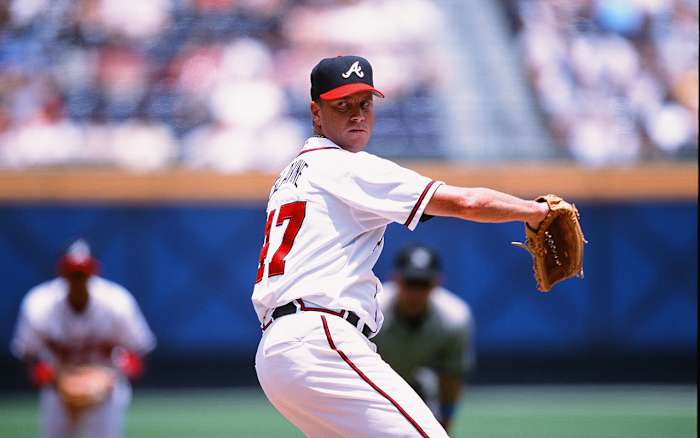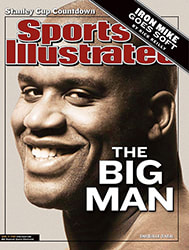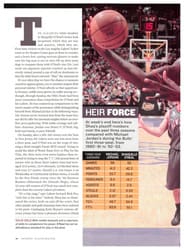Both Sides Now
Seeming to operate outside the purview of time, Tom Glavine still wears number 47 for the Atlanta Braves; still marches to the mound, head down, with that purposeful, splay-footed walk; still appears youthful and undersized; and still throws with an exquisite economy of motion that keeps virtually all of his pitches within a narrow and unspectacular band of seven miles per hour. (This is how composer Philip Glass would pitch if he had a changeup from hell.) The familiar minimalism of Glavine dares you to find any difference in him between 1991, when he won 20 games and the Cy Young Award at age 25, and 2002, when last Thursday he reached 10 wins earlier than in any of his previous 15 big league seasons.
"You'd find almost no difference at all," Atlanta general manager John Schuerholz says of the 6-foot, 185-pound lefthander, "except for maybe a few gray hairs."
Should you assume, however, that the Glavine you see today is the same Glavine you've seen for all these years, consider yourself his latest victim. You've just been caught looking. Glavine is winning as he never has before. No longer just a fastball-changeup savant who lives on the outside part of the plate (give or take a few inches granted by generous umpires), Glavine has broadened his repertoire to include backdoor sliders, cut fastballs and--gasp!--regular visitations to the inside corner.
"I don't know if I've ever seen him this good for this long," says Bobby Cox, the Braves manager since 1990, of his five-time 20-game winner. "He's been locked in all year. He's probably better now than he's ever been."
Says four-time Cy Young winner Greg Maddux, Glavine's running mate in the Atlanta rotation for 10 seasons, "He is better than he's ever been, and it's not even close. He's throwing the ball on both sides of the plate now, and he's doing it with all of his pitches. He's tying up hitters inside, which opens up the outside corner for him. He's going to win 20 games again, and he's doing it with an ERA about two runs lower than he's had in the past."
At week's end Glavine (10-2) led the majors with a 1.64 ERA, well ahead of his career ERA entering this season (3.40) as well as his personal best (2.47 in 1998). He had not allowed a home run with a man on base, had not walked a No. 8 or 9 hitter and had yielded only nine hits in 74 at bats with runners in scoring position.
When he stifled the New York Mets over seven dogged innings of the 3-2 victory on Thursday, Glavine became only the sixth pitcher since the expansion era began in 1961 with a career record 100 games better than .500 (chart, page 70). Glavine and Maddux (263-148) are the first teammates to be at least 100 games above .500 since 1908, when Christy Mathewson and Joe McGinnity were in the New York Giants' rotation. A true throwback, Glavine is the only pitcher of the free-agent era to amass 234 wins with his original team--and only the 16th in the history of the game to do so.
What may be even more startling is that Glavine won most of those games without throwing a breaking ball. Oh, he has a curveball, but that's like saying Eminem has a suit and tie in his closet. His curve is so poor that Glavine rarely breaks it out. "It's a good curveball for 58 feet," he says, "but it's lousy for 60 feet."
Glavine has been fooling batters for years, mostly because of a changeup he serendipitously discovered in 1990. One day he was shagging baseballs in the outfield during batting practice when he happened to pick up a ball awkwardly--his left index finger off the ball and resting outside of his thumb--and flung the ball to a teammate. Glavine noticed the ball came out of his hand more softly than it should have, given how hard he'd thrown it, so he experimented with the grip the next time he threw off a mound in the bullpen. The changeup immediately felt comfortable.
Glavine typically throws the changeup about 81 mph. His fastball mostly resides in the 88 mph neighborhood. He has thrown those pitches so often and to the same spot--the lower lefthand corner of the strike zone to a righthanded batter--that he could probably hit his mark with either pitch blindfolded. "Yeah, after a pitch or two to get adjusted, I could do it," he says.
Glavine and Maddux established their low-and-away strikes with such precision throughout the 1990s that they became the pitchers most identified with the squashing of the strike zone--it became shorter and wider (wider, many said, than the plate). Baseball officials vowed in '99 to return the zone to the width of the plate. "I didn't handle it well," Glavine says. "I went out there anticipating changes rather than reacting to them. I wound up creating problems for myself." That season Glavine had a 4.12 ERA, his worst since 1990, and gave up a major-league-high 259 hits. He rebounded with a 20-win season in 2000, a year, he says, when strike-zone reform and rhetoric abated. Vigorous enforcement of the zone returned last year, however. "When they did it in '99, they did it for a while and then got away from it," Glavine says. "Last year they really seemed to be conscious of it all season."
Flustered again by the crackdown, Glavine pitched poorly. On June 18, 2001, the Braves gave him a 5-0 lead in the first inning against the Florida Marlins. Glavine gave it all back, surrendering two runs in the second and three more in the third. Though Glavine didn't get the decision, the Braves lost 7-6, and he left the game with a 6-5 record, a bloated 5.12 ERA and an alarming lack of confidence for someone pitching coach Leo Mazzone calls "the strongest-minded individual I've ever been around. If you had to pick one guy to compare him to, it would be Whitey Ford."
The Braves like to tell the story of Glavine's bravado in the clinching game of the 1995 World Series, when he beat the Cleveland Indians 1-0 while allowing one hit over eight innings. The game was scoreless in the middle of the fifth when Glavine marched into the dugout and screamed, "C'mon! Let's get a run! Because I know they sure as hell aren't getting any."
Mazzone turned to Cox and said, "Did you just hear that?" Cox nodded. Then the pitching coach and manager smiled at each other knowingly.
That kind of assuredness, however, was gone midway through last season, especially in that start against Florida. Says righthander John Smoltz, Glavine's teammate since 1988, "I didn't like what I was seeing." So in the first inning of the game the next night, Smoltz walked over to Glavine and sat next to him on the bench. "I knew what was coming," Glavine says. "Smoltzie gave me a little heart-to-heart."
Says Smoltz, "I thought he had given in to the situation, and I told him that. I thought he had reached the point of, Screw it. Whatever happens, happens. I told him that was wrong. That he was going to have to find a way to fight through it."
Since then Glavine has lost only four times in 34 starts, winning 20 while compiling a 2.13 ERA. It was during last season's second-half revival that Glavine began mixing in more cut fastballs, which bore in on the hands of righthanded hitters, and throwing his venerated changeup inside to righties, a taboo in baseball. Pitchers typically are reluctant to throw off-speed pitches inside, because mistakes--left up or over the plate--are easily crushed. For years, however, Maddux has defied convention by throwing changeups and sliders inside. Cox said Glavine warmed to the idea by watching Maddux.
"I starting pitching inside more last year out of necessity," Glavine says. "Things weren't coming as easily to me as they had in the past, so I had to find something else. All of a sudden I'm throwing fastball in, cutter in and changeup in--and all of them look very similar coming out of my hand."
Glavine added yet another pitch this year, the backdoor slider, a breaking ball to righthanded hitters that looks like a fastball wide of the strike zone but curls back to nip the outside corner. He uses the pitch infrequently yet effectively. For instance, he threw one on a 2-and-2 count to Mets leftfielder Roger Cedeno on Thursday. Cedeno stared at it as if it were a UFO. The pitch was called strike three.
Though Glavine can't throw a decent curveball and almost never hits 90 mph on the radar gun, he has earned $70 million in baseball and, after his five-year, $42 million contract expires at the end of this season, he is due for more riches. Glavine and Maddux could be free agents next fall. The Braves have not opened negotiations with either, preferring to see how they pitch this season and what happens with labor negotiations. Some Atlanta players are puzzled as to how the club could be so passive with franchise institutions. Both pitchers prefer to stay. "It doesn't concern me now," Glavine says, "but I know I'm in a position where the better I do, the more I can enhance my position."
Glavine says he is looking for a three-year deal, with thoughts about 300 career wins and a place in Cooperstown. Other than two weak ankles, which prevent him from running sprints, Glavine is in peak physical condition. He has never had a major injury to his arm. He takes just one week off a year from training--the week after Atlanta's season ends--and is stronger than his silhouette would suggest.
"His lower-body strength is well above average," Braves strength-training coach Frank Fultz says of Glavine. "He leg-presses 1,000 pounds. His back is exceptionally strong, as strong as any position player's. The word I would use with Tommy is relentless. He works at it. Years ago I was with the Houston Astros. He reminds me of Nolan Ryan that way. He called me up Thanksgiving morning last year and said, 'Frank, get over here,' and I put him through his workout when everybody else was doing their turkeys and all the trimmings."
In that 1995 Series clincher against Cleveland, Glavine noticed in the middle innings that the Indians were moving up in the batter's box or closer to the plate. "You have two choices," Mazzone said. "You can come inside, or you can go farther out." Glavine saw comfort in only one course then. He aimed farther away, and the Indians took the bait. Now Glavine has more options. He may cut the most familiar figure of any pitcher since the reserve clause was struck down, but look closely and you discover the trompe l'oeil that is Glavine. He's never been this good.
"Every time out this year I've felt like I could pretty much execute the way I wanted," he says. "Usually there's a game every five or six starts where things don't go right. Your mechanics get out of whack, and you have to work to get back on track. That hasn't happened yet. I don't know if it's possible to go all year long like that. It might just be one of those years."


